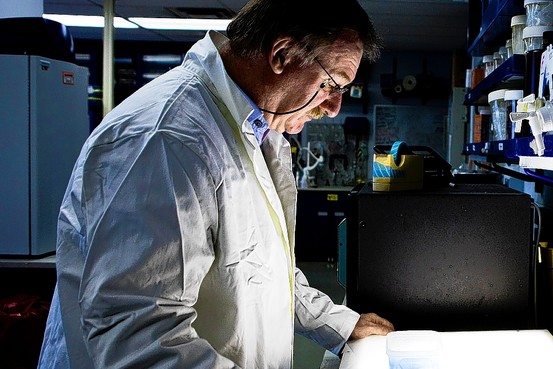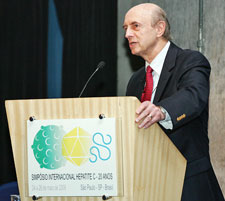Discuss this article on the forums
 I was sitting in Starbucks browsing the front page of the Wall Street Journal – and saw something about “War on Mystery Disease”….and there’s no way…… and then gulped. Yes, chronic fatigue syndrome was the Front Page of the most popular and influential newspaper in the United States. That’s right more people read the Wall Street Journal than any other newspaper…by far.
I was sitting in Starbucks browsing the front page of the Wall Street Journal – and saw something about “War on Mystery Disease”….and there’s no way…… and then gulped. Yes, chronic fatigue syndrome was the Front Page of the most popular and influential newspaper in the United States. That’s right more people read the Wall Street Journal than any other newspaper…by far.
The closest competitor to the WSJ is USA Today which is hardly known for it’s investigative articles. The New York Times with 2 1/2 times less circulation isn’t even close. If you want to combine numbers and influence where you want to end up is on the front page of the Wall Street Journal.
And that’s where Amy Dockser Marcus’s latest article on CFS landed. It’s been a long, long time since CFS has been on the front page of “one of the biggies” let alone the WSJ. The article isn’t entirely positive about the expectations of the CFS community but having it show up where it is provides us the opportunity to seize this moment. It’s vital that we keep CFS in the national discussion.
Comment, Comment, Comment! Please click on the article and comment on it and email it; we know from our history that that is key to getting the federal government to spend money on a disorder they obviously would rather not.
Much of the article is about the ‘clash’ between patients and the research establishment regarding XMRV. What it doesn’t focus on is every other area in ME/CFS that’s been ignored. For me my comments will focus on the pathetic and really almost criminal under-response the federal government has shown to this disorder and note that the anxiety about XMRV is simply a reflection of patients responding to long standing historical trends. This is an easy way to turn the discussion about patients perhaps too high expectations into a discussion of how this disorder has been treated by the federal government; ie that its basically been ignored.
The WSJ has put alot of work into this; there is a video on CFS and an interactive graphics section and check out Bob Miller! He’s all over the article :) Chris Cairns is mentioned as well. Let’s support Amy and get all over this article.
https://online.wsj.com/article/SB10001424052748704008704575639193973468402.html?mod=ITP_pageone_0
Robert Miller was working as a coal miner in Utah in 1982 when he got the flu and “it didn’t go away.” Diagnosed with chronic fatigue syndrome in 1994, he has been living ever since with symptoms that include constant pain, an inability to concentrate and exhaustion so severe, he can’t lift his arms.
Worse than his condition, Mr. Miller says, has been the humiliation and ostracism he’s suffered from the scientific establishment, which he accuses of ignoring or downplaying the existence of the disease for the past 25 years.
Now, after a 2009 study claimed to find a link between chronic fatigue syndrome and a virus called XMRV, the 52-year-old has become a leader in patient efforts to push scientists to finally solve the mystery of his disease. He’s attending scientific conferences, organized patient meetings with government officials and helped mastermind an advocacy campaign that sent daily emails to government agencies demanding action.
 Stuart Le Grice is skeptical about XMRV’s role in the disorder. As head of the National Cancer Institute’s Center of Excellence in HIV/AIDS and cancer virology, he is sympathetic to Mr. Miller and other patients. But he insists that science can’t be rushed. Desperate patients who want immediate answers risk diverting attention from essential research. “There’s a danger of deflecting us from what we really want to do,” Dr. Le Grice says.
Stuart Le Grice is skeptical about XMRV’s role in the disorder. As head of the National Cancer Institute’s Center of Excellence in HIV/AIDS and cancer virology, he is sympathetic to Mr. Miller and other patients. But he insists that science can’t be rushed. Desperate patients who want immediate answers risk diverting attention from essential research. “There’s a danger of deflecting us from what we really want to do,” Dr. Le Grice says.
The two viewpoints show the gaping divide between many chronic fatigue syndrome patients and scientists studying the disease. Although research linking XMRV and a family of retroviruses to CFS is still preliminary, an emotional debate has exploded over whether the finding is correct.
Patients seeking a speedy cure for all sorts of diseases have clashed before with scientists, who insist that science has to follow prescribed steps to be conducted properly. As the debate over XMRV illustrates, such clashes are starting at increasingly early stages of the scientific process, sometimes altering the way research is conducted.
The Internet has given patients the ability to organize and rapidly disseminate medical information—and rumors as well. Patient advocacy groups are increasingly powerful, involved in central endeavors such as funding research and collecting samples critical to experiments. Patients say they bring a sense of urgency, forcing scientists to collaborate in order to speed up the search for therapies. They say that scientists often pursue research questions that are intellectually interesting but bring them no closer to finding cures. Scientists warn that putting early science in the public spotlight can not only slow down research, but also backfire. “The faster we try to go, the bigger chance we have of overlooking some small but important point,” Dr. Le Grice says.
Controversy has long surrounded CFS, a debilitating condition characterized by symptoms that include severe fatigue and pain and cognitive disabilities. Nearly 25 years after the “Lyndonville outbreak” of chronic fatigue syndrome, a controversy is brewing among scientists over what causes the disease. A small-town doctor hopes his patients will help provide the answer. WSJ’s Jason Bellini reports.
There has never been any consensus on what causes the syndrome. Many doctors believe that there can be different triggers, including viruses and genetic vulnerability. There are still some doctors who believe the condition is psychiatric, a stance many patients believe has discredited them and slowed down efforts to find treatments.
The finding linking XMRV and related retroviruses to the condition offered patients evidence that there was an infectious source. When an FDA committee recommended that people with chronic fatigue syndrome be barred from donating blood last year, many patients welcomed the decision because it finally legitimized the illness.
But no sooner did the XMRV paper offer hope to patients than a heated disagreement began with scientists: Some labs haven’t been able to find a single case of XMRV in either patients or healthy people. Scientists disagree among themselves on how prevalent XMRV really is in the population. Papers published in the past few months suggested that some of the evidence supporting a link to chronic fatigue syndrome and prostate cancer may be the result of contamination. Even if XMRV turns out to be widespread, scientists don’t know for certain if XMRV causes disease, or whether one of those diseases is chronic fatigue syndrome.
Eager to find treatments and suspicious that their condition is not being taken seriously, patients have accused some of the scientists of taking too long to get answers. Patients say some scientists are even deliberately setting up experiments designed to fail to find XMRV.
After the Centers for Disease Control and Prevention published a study in July that didn’t find XMRV in either patients or healthy people, patient advocate Mindy Kitei wrote on her blog that CDC didn’t want to find XMRV.
“If the CDC had found the retrovirus,” she wrote, “it would have negated its 20-year affair with chronic fatigue syndrome as a psychological problem.”
“Most of the public is not accustomed to evaluating early stage science, and they don’t understand how vague things are at this point,” Alan Dove, a science writer who trained as a microbiologist at Columbia University, commented during a podcast, “This Week in Virology,” that discussed XMRV.
The clashes between patients and scientists come as science in general becomes more polarized, according to a study published in the Journal of Risk Research last year. Researchers found that when scientists’ conclusions conflict with a community’s cultural values, people don’t accept the scientific consensus. “The phenomenon we are looking at is a cultural war over facts,” says Dan Kahan, director of the Cultural Cognition Project at Yale Law School, who co-authored the study last year.
 Harvey Alter, a 75-year-old hematologist who is a member of the National Academy of Sciences, says the intensity of the XMRV debate took him by surprise. At a small conference in Croatia last May, Dr. Alter gave a talk about the risk of infectious viruses in blood transfusions and presented one slide mentioning XMRV. He told the scientists present that he thought the findings in 2009’s paper, in the journal Science, were likely true and that he had some early data that appeared to back it up.
Harvey Alter, a 75-year-old hematologist who is a member of the National Academy of Sciences, says the intensity of the XMRV debate took him by surprise. At a small conference in Croatia last May, Dr. Alter gave a talk about the risk of infectious viruses in blood transfusions and presented one slide mentioning XMRV. He told the scientists present that he thought the findings in 2009’s paper, in the journal Science, were likely true and that he had some early data that appeared to back it up.
He didn’t present his data, he said, because it was too preliminary. But he brought it up because eventually it could have public health implications.
“I thought it was important they know what might be coming,” he said.
The conference organizers put the presentation on the web, and two Danish journalists issued a press release about the brief XMRV remarks.
For weeks, Dr. Alter, who works at the NIH, was hounded by reporters and patients demanding more information—information that Dr. Alter says he didn’t feel was ready for presentation.
“It never dawned on me that one sentence would have such impact,” he says. He couldn’t respond to all the email and worried that any comments might be misinterpreted.
The controversy intensified after reports that a research paper Dr. Alter was preparing was accepted for publication, but that he withdrew it out of concern that his results differed from a CDC study that didn’t find XMRV.
On chronic fatigue syndrome blogs and chat groups, patients questioned the motivations for the rumored delay. Christopher Cairns, whose daughter has chronic fatigue syndrome and who writes a popular blog called The Patient Advocate, wrote that he believed pressure was coming from CDC to delay Dr. Alter from publishing.
“Their single desperately focused goal is to slow the momentum—and in the process to choke the money flow” for more XMRV research, he wrote.
Dr. Alter says there was nothing amiss: He simply needed more time to analyze why his finding differed from the CDC’s. He says the pressure and meetings and discussion kept him out of the lab, where he wanted to finish his experiments.
“I could understand the reasons people were so anxious to get the answer, but I couldn’t convey the reasons why it was important for science to run its own course,” says Dr. Alter.
His paper, which found a connection between chronic fatigue syndrome and a family of viruses to which XMRV belongs, was finally published in September.
Dr. Le Grice, the NCI scientist coordinating XMRV efforts, says that the science about XMRV has actually moved very quickly. He says patient pressure has helped draw attention not to the virus but to the seriousness of chronic fatigue syndrome.
“We’ve been on this a year now. To a chronic fatigue syndrome patient, I’m sure a year seems like a long time. In science, what we’ve done in a year is incredibly fast,” says Dr. Le Grice.
Dr. Le Grice says he is no stranger to the politics of science and advocacy: He spent years developing anti-retroviral drugs at a drug company and then running a university center for AIDS research. Still, the 58-year-old biochemist is sometimes taken aback by patients’ suspicion of the motives of scientists investigating XMRV.
 The clash between the two sides was sharpest at an NIH-sponsored meeting about XMRV last year. After the CDC’s William Switzer presented data about an XMRV test his team developed, patient advocate Ms. Kitei questioned whether Mr. Switzer really wanted to find XMRV at all. “You seek what you want to seek,” she said.
The clash between the two sides was sharpest at an NIH-sponsored meeting about XMRV last year. After the CDC’s William Switzer presented data about an XMRV test his team developed, patient advocate Ms. Kitei questioned whether Mr. Switzer really wanted to find XMRV at all. “You seek what you want to seek,” she said.
Jonathan Stoye, a British scientist who was moderating the panel discussion, asked Ms. Kitei to stop her line of questioning. “I think nobody in this business is trying to get a negative result,” he told her. “It’s in nobody’s interest.”
Ms. Kitei replied: “Of course it is…. The CDC has said this is a psychogenic illness for 26 years.” She tried to say more, but Dr. Stoye cut her off. “We’re not here to discuss the CDC,” he said.
The CDC denies any effort to discredit the disease. “I take issue with people who would make the accusation that CDC went into this whole process with the intention to come up with negative results, because that was certainly not the case,” said Stephan S. Monroe, CDC’s director of the division of viral and rickettsial diseases.
Indeed, there is no evidence the CDC sabotaged efforts to find XMRV. But many patients believe the agency hasn’t worked hard enough to find a cause for the disorder.
 Mr. Miller, for one, questions CDC studies that he says are denigrating and irrelevant to those with the disease. For example, a paper by CDC researchers was published in July, shortly after the CDC said it could not find XMRV in patients. It reported that 29% of chronic fatigue syndrome patients in the study had a personality disorder compared with 7% of healthy controls.
Mr. Miller, for one, questions CDC studies that he says are denigrating and irrelevant to those with the disease. For example, a paper by CDC researchers was published in July, shortly after the CDC said it could not find XMRV in patients. It reported that 29% of chronic fatigue syndrome patients in the study had a personality disorder compared with 7% of healthy controls.
Mr. Miller says he went to the NIH’s XMRV conference because science is often “filtered” to patients through doctors or advocacy groups, and he wanted to hear and assess the scientific debates for himself.
At the NIH meeting, Mr. Miller says he was surprised the scientists hadn’t agreed on a standardized way to find XMRV or related retroviruses before launching experiments. Extensive debate at the meeting centered on figuring out why some labs found XMRV and others could not.
“It was a true eye opener that they aren’t sharing information or having discussions beforehand,” says Mr. Miller.
These sorts of disagreements, say scientists, are typical of early research, but they usually do not take place in the public eye. Many scientists will not share early results beyond a very tight group of trusted colleagues before publication. They want to make sure of their results before they present them, since other scientists will then try to replicate the data. They also need to publish to make sure someone else does not take credit for their discoveries.
In the harsh public glare, the traditional culture of science is turned upside down. Dr. Le Grice is worried that public pressure will cause scientists to rush, resulting in experiments that end up “clouding the field even more.”
In mid-October, Dr. Le Grice and Mr. Miller found themselves once again attending the same meeting—this time, a scientific session before members of the chronic fatigue syndrome advisory committee, which makes policy recommendations to the head of Health and Human Services.
Dr. Le Grice gave a presentation on XMRV that summarized the debate that went on at the NIH workshop. He raised concerns among the scientists about mouse DNA contaminating the samples. Afterward, the two men had a chance to briefly talk. They still do not see eye to eye.
Mr. Miller felt that in summarizing the presentations, Dr. Le Grice was too negative.
Dr. Le Grice explained that because of Mr. Miller’s patient-advocacy email campaign, Dr. Le Grice has less time to spend doing science about XMRV.
Mr. Miller says that in the past, he doubted whether science would yield answers to his medical condition. He still worries that the controversy will cause money for research to dry up, before all the scientific questions are fully answered.
But the debate over XMRV has changed at least one thing. After they talked, Dr. Le Grice looked Mr. Miller in the eye and told him that he has no other agenda except to find out whether XMRV represents a threat to people.
“I believe him,” says Mr. Miller.[/COLOR][/COLOR]
